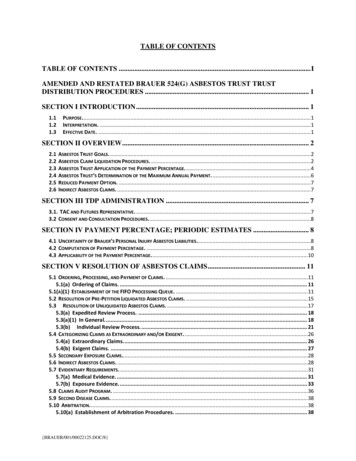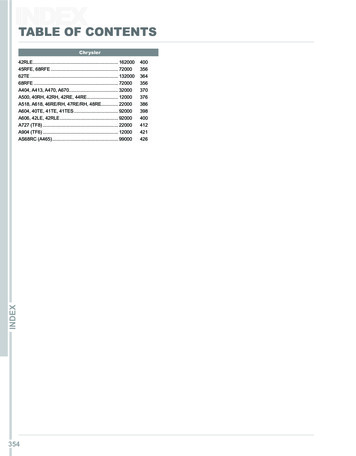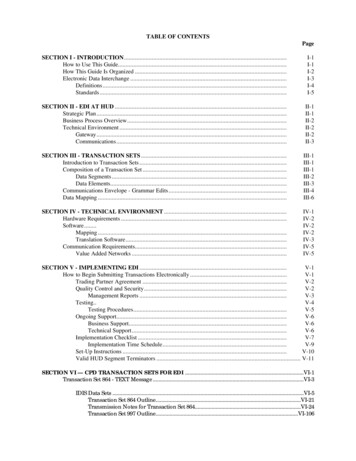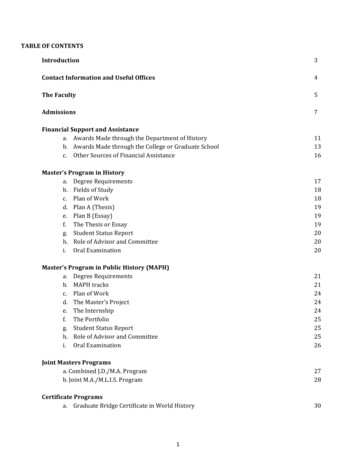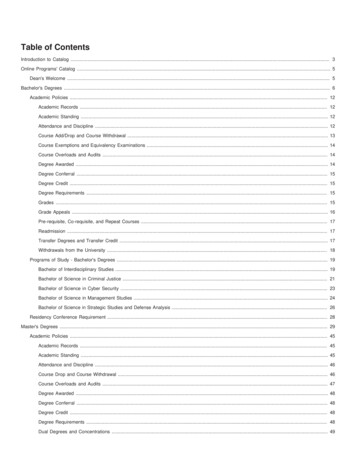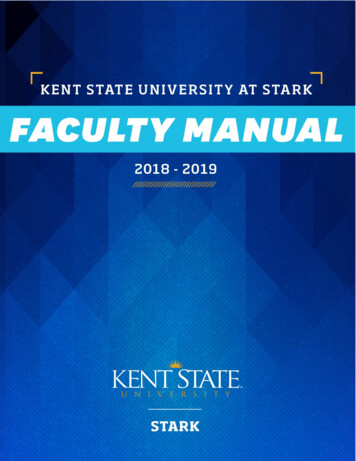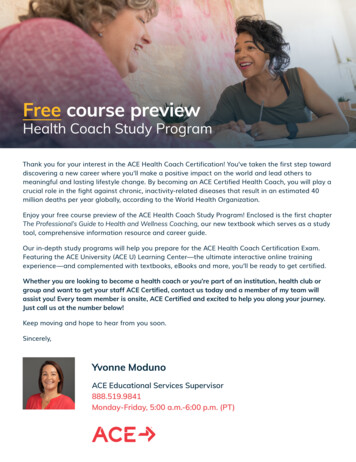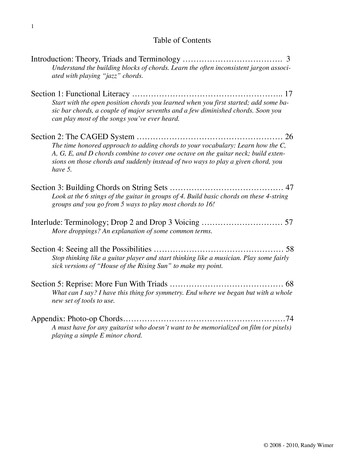
Transcription
1Table of ContentsIntroduction: Theory, Triads and Terminology . 3Understand the building blocks of chords. Learn the often inconsistent jargon associated with playing “jazz” chords.Section 1: Functional Literacy . 17Start with the open position chords you learned when you first started; add some basic bar chords, a couple of major sevenths and a few diminished chords. Soon youcan play most of the songs you’ve ever heard.Section 2: The CAGED System 26The time honored approach to adding chords to your vocabulary: Learn how the C,A, G, E, and D chords combine to cover one octave on the guitar neck; build extensions on those chords and suddenly instead of two ways to play a given chord, youhave 5.Section 3: Building Chords on String Sets 47Look at the 6 stings of the guitar in groups of 4. Build basic chords on these 4-stringgroups and you go from 5 ways to play most chords to 16!Interlude: Terminology; Drop 2 and Drop 3 Voicing 57More droppings? An explanation of some common terms.Section 4: Seeing all the Possibilities 58Stop thinking like a guitar player and start thinking like a musician. Play some fairlysick versions of “House of the Rising Sun” to make my point.Section 5: Reprise: More Fun With Triads 68What can I say? I have this thing for symmetry. End where we began but with a wholenew set of tools to use.Appendix: Photo-op Chords 74A must have for any guitarist who doesn’t want to be memorialized on film (or pixels)playing a simple E minor chord. 2008 - 2010, Randy Wimer
2ForewordFirst, this book is for everyone who has made it through the beginning phases of learning guitar. Ifyou’re ready to expand your chord vocabulary, this book is for you.Second, this book is not meant to be worked through in a month or three. The material in each section should be learned and then incorporated into the guitarist’s everyday playing before proceeding to thenext section. If you’re just starting out, work through the ‘Functional Literacy’ section and live with it for awhile. Apply those new chords to songs you know. Learn some new songs you couldn’t play before. Whenthat material is easy for you, when you’ve internalized the ideas, then move on to the ‘CAGED’ chapter.What I’ve tried to do in this slender volume is to chronicle the normal evolutionary cycle of guitaristswho develop a truly deep understanding of harmony applied to the guitar fretboard. It’s the path I wentdown over the course of many years. It’s the same or very similar to the paths that many of my friends andcolleagues have followed. And yet I’ve never seen the material presented in this fashion. Hopefully this willprovide some markers on the trail for aspiring guitarists. 2008 - 2010, Randy Wimer
3 2008 - 2010, Randy Wimer
4The Whole Chord ThingIntroductionShredders get all the attention. But even they know in their heart of hearts that real mastery of the instrument is shown through a clear understanding of chords and how they work on the guitar fretboard.Working through this book will allow you to accomplish two things: 1) you will acquire a firm grasp ofchord theory along with the basic chord shapes to get you through most playing situations - whether you’replaying in a 3-piece rock band or a 17-piece jazz ensemble; 2) you will acquire the tools to define your own‘chord voice’. Joe Pass played chords differently from Barney Kessel. Alan Holdsworth plays chords differently than Frank Gambale. If you really want to master the guitar, your chordal style needs to be as personal as your improvisation style.In the introductory section of this book we’ll look at the rules of music theory that govern chord building; we’ll take a detailed look at triads; and we’ll try to unravel the sometimes arcane and conflicting terminology that applies to chords.Basic TheoryThe space between two notes is called an interval. The smallest space you can have between two notesis a half-step, one fret on the guitar. I like to think about note relationships, and eventually chords, spatially.Start with the chart below listing the notes of a one-octave chromatic scale from C to C. Each box represents a single half-step.CC#DbDD#EbEFF#GbGG#AbAA#BbBCTo understand the way we name the intervals we must first look at a major scale. Below we’ve removed the sharps and flats and we’re left with the notes of a C major scale.CDEFGABCIntervals are named with numbers. If we want to know the interval between a C and an E, we simplycount: C, D, E; 1, 2, 3; the interval is a third. How far is it between C and A? C, D, E, F, G, A; 1, 2, 3, 4, 5,6; This interval is a sixth. What is the interval between D and F? It’s another third. But notice it’s fartherfrom C to E than from D to F.CDEDEFThere are 4 half-steps between C and E and 3 half-steps between D and F. The larger interval is called amajor 3rd and the smaller is a minor 3rd. The chart below shows the interval name and the associated number of half-steps between C and all the notes in the octave above on 2008 - 2010, Randy Wimer
5TMI WarningIf you get a good handle on the information so far, that’s really most of what you need to understandhow chords are built. So .this next bit may come under the heading of too much information. If you begin to bog down in the rest of the material on intervals, don’t worry. Skip it for now and come back to itafter you’ve had a chance to digest for a while.Notice that the sharps have been removed from the preceding chart. There are other considerations besides the number of half-steps when identifying intervals: C to D# is not the same as C to Eb. Yes, D# andEb are the same pitch, but when identifying intervals you also have to consider the letter names of the notes.Count the letters from C to D# - it’s still C, D; 1, 2 - a second of some kind even though it’s a D#. We callthat space an augmented second. The chart below uses the sharps and the alternate names of the tedunisonMajor2ndAug2ndMajor3rdAug5thMajor6thAug 6thMajor7thPerfectoctaveunisonPerfect Aug 4th Perfect4th5thSo, you’ve got this interval thing covered, right. Not quite. There is one (only one, I promise) morething to consider when naming intervals: mixed accidentals - the use of sharps in a flat key signature (orvice-versa). Consider the following:The first note is an F sharp (note the key signature) and the second is an Aflat. That’s a distance of 2 half-steps, or one whole step. But, again, wehave to consider the letter names of the notes, F and A. That’s F, G, A; 1,2, 3, so the interval has to be a kind of third. A major third is 4 half-steps, aminor third is 3 half-steps. This new beast is called a diminished third. I tend to relate this stuff back to theintervals derived from the major scale. In the C major scale, C to A is a major sixth; C to A flat is a minorsixth. We can make that interval smaller (diminished, get it?) by either raising the the C to a C sharp or lowering the A flat to an A double-flat. Either case would be called a diminished sixth. Will you need to understand diminished intervals to complete your knowledge of chords? Not really - where it becomes relevant isin formal music theory study, generally within the first couple of college music theory. It that’s not yourpath then consider it knowledge for knowledge’s sake. Not a bad thing. 2008 - 2010, Randy Wimer
6Major ChordMinor ChordCx3 2 0 1 0Root positionDiminishedChordMajor ThirdStart with two basic rules: Chords are built inthirds; and chords must contain at least 3 different tones.There are two types of thirds (that we dealwith here), major 3rds (4 half-steps) and minor3rds (3 half-steps). To the left are the possiblecombinations of thirds in simple 3-note chords,called triads.Using C as a starting point, the notes, and formulas for the chords are:Major: C E G, Root 3 5Minor: C Eb G, R b3 5Diminished: C Eb Gb, R b3 b5Augmented: C E G#R 3 #5Major ThirdMinor ThirdMinor ThirdMinor ThirdMajor ThirdMajor ThirdMinor ThirdUsing Intervals to Build Chords: TriadsAugmentedChordLet’s actually look at the guitar (and the crowd cheers). If you’re normal (not agiven, knowing the types who seek out this kind of material), one of the firstchords you learned was a C chord. This is not a triad. It is, however, built from atriad. We know from the chart above that the notes of a C major triad are C, Eand G. In the simple, open C chord to the left, the notes, from 5th string to 1st,are C, E, G, C and E. We just double the C and E at the octave to give the chordmore fullness. This is the same for most of the open chords we all learn when westart to play the guitar. A Triad is just the three notes, C, E and G in this case,with no doubles.Below are three of the four possible triads that can be built from our basic openC chord. Notice that the notes are intheir most compact form. These arecalled closed voicings, sometimes blockvoicings. If the root of the triad is in thebass (the lowest note), the triad is in rootposition; if the third is in the bass thetriad is 1st inversion; and if the fifth is in1st inversion2nd inversionthe bass the triad is in 2nd inversion. 2008 - 2010, Randy Wimer
7If we take the middle note of each of the previoustriads and raise it an octave, spreading the notesover a larger range, we get an open voicing. At leftare the root position, 1st and 2nd inversion, openvoicing triads that are most closely related in structure to the C chord.Triads: What Good Are They?Why should you invest your precious time in learning triads? Three practical and one intellectual reason: 1) there are some truly classic R&B rhythm guitar figures that are based on triads (as well as countryand rock tunes); 2) complex chords can be broken into component triads and those triads can be used to create interesting rhythm guitar parts; 3) even though the purpose of this book is to learn chords, some verycool lead guitar ideas come from triads; and 4) learning and practicing triads will increase your understanding of how music theory works on the guitar fretboard.Examples of triad useThis example simply takes the I, IV and V triads of the key and arpeggiates them over the pedal D.This is a common blues figure. After playing the root A note, the player slides an F# minor triad down awhole step to an E minor triad. The resulting harmonies are A6 sliding into an A9. 2008 - 2010, Randy Wimer
8Learning TriadsWe’ll do three different triad exercises. The first will explore the possible closed voicing shapes. The second will take those shapes and move them through a harmonized scale. Finally, we’ll move open positiontriads through a harmonized scale.Part 1, Triad ShapesMinorMajor132231315 R b35 R 3221AugmentedDiminished1321b5 R b333131#5 R 324113 fr3 5 R431b3 5 R423 #5 Rb3 b5 R14213213 frR 3 5231R b3 b53 41R b3 b5231R 3 #53214 fr5 R 35 R b3b5 R b3#5 R 3 2008 - 2010, Randy Wimer
9MinorMajor211132133135 R 33113 5 R11141311b3 5 R21231312b3 b5 R112R 3 #513b5 R b3333 #5 RR b3 b55 R b322b3 b5 RR b3 b5R 3 521b3 5 R3 5 RAugmentedDiminished21#5 R 33213 #5 R 2008 - 2010, Randy Wimer
10MinorMajor3413234211231R 3 5331421R b3 512R b3 b51231311221R b3 b5111#5 R 323b3 b5 R43R 3 #5b5 R b3b3 5 R3 5 R415 R b35 R 332R b3 5R 3 5AugmentedDiminished213 #5 R321R 3 #5 2008 - 2010, Randy Wimer
11Part 2, Closed Voicing Triads Through a Major ScaleSecond inversionRoot positionFirst inversionRoot positionI’ve given you one selection from each group of strings as an example. The wise student will work throughall 12 keys, using each of the three triad shapes. The unwise student will skim over the material and think,“I’ve got this - no big deal”. He will later flunk out of the second semester of music theory, ruining his GPAand any hopes of a college degree and end up as an assistant manager in a What-a-burger in North Dakota. 2008 - 2010, Randy Wimer
12Part 3, Open Voicing Triads Through a Major ScaleFor these examples I’ve fingered the triads more in the manner of a classical guitarist. The arpeggiationshould be easily played with either the fingers or a pick.Root positionSecond Inversion 2008 - 2010, Randy Wimer
13First InversionBeyond Triads:Theory and Naming ConventionsFor Extended ChordsYou know what I’m talkin’ ‘bout; all that G13b9 and D7#9 kind of stuff. All of the ridiculously named,complex sounding chords start with a simple triad. Remember the basics: chords are built in thirds; there aretwo kinds of thirds, major and minor. As we stack another third on top of the triad (extending the chord tothe seventh), we build new chords. Start with a major triad: If I add a major third on top of the G, the highest note in the C major triad, the notes of the chord are C, E G andB, a C major 7 chord (Root, 3, 5 and 7). If I add a minor third, thatadded note is a Bb, creating a Dominant 7 chord (Root, 3, 5 andb7). “What’s this dominant thing,” I hear you asking. “I don’tC Major 7 C7swing that way.” No, no, no.not that kind of dominant. You went throughthe triad exercises, right? You played the chords built from the successive notes of a major scale, subsequently abbreviated, I, ii, iii, IV, V, vi, and vii . In classic theory each of these chordal positions has aname: John, Paul, George.once again, forgive me. In order, the names are: I - Tonic; ii - Supertonic (letyour imagination run wild); iii - Mediant; IV - Subdominant; V - Dominant; vi - Submediant; and vii Leading tone. Major triads are on the first (Tonic), fourth (Subdominant) and fifth (Dominant) . Look at thekey of C; on the Tonic, go a third above the 5 (G) and you get a B, an interval of a Major third. As we havealready established, that is a C Major 7 chord. Look at the Subdominant, F. Again, go a th
voicing triads that are most closely related in struc-ture to the C chord. Triads: What Good Are They? Why should you invest your precious time in learning triads? Three practical and one intellectual rea-son: 1) there are some truly classic R&B rhythm guitar figures that are based on triads (as well as country
